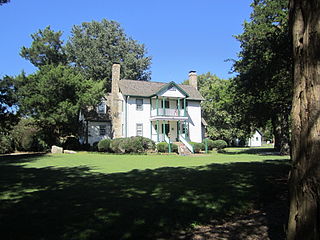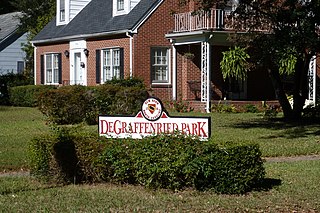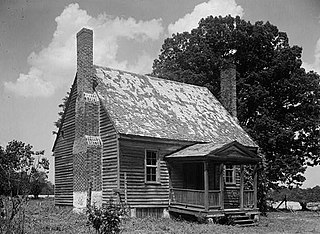
Brookgreen Gardens is a sculpture garden and wildlife preserve, located just south of Murrells Inlet, in the U.S. state of South Carolina. The 9,100-acre (37 km2) property includes several themed gardens featuring American figurative sculptures, the Lowcountry Zoo, and trails through several ecosystems in nature reserves on the property. It was founded by Archer Milton Huntington, stepson of railroad magnate Collis Potter Huntington, and Anna Hyatt Huntington, his wife, to feature sculptures by Anna and her sister Harriet Randolph Hyatt Mayor, along with other American sculptors. Brookgreen Gardens was opened in 1932. It was developed on property of four former rice plantations, taking its name from the former Brookgreen Plantation, which dates to the antebellum period.

Stagville Plantation is located in Durham County, North Carolina. With buildings constructed from the late 18th century to the mid-19th century, Stagville was part of one of the largest plantation complexes in the American South. The entire complex was owned by the Bennehan, Mantack and Cameron families; it comprised roughly 30,000 acres (120 km2) and was home to almost 900 enslaved African Americans in 1860.

The Bennett Bunn Plantation is a historic farm near Zebulon, North Carolina, a suburb of Raleigh. The plantation, located beside US 264 in eastern Wake County, consists of a two-story house, built in 1833, barns, and 162 acres (66 ha) of farmland and forests. The property was owned by generations of the Bunn family until 2000 when Grace Hutchins, great-granddaughter of Bennet Bunn, sold the property for $1.9 million. The home is still used as a private residence and was listed on the National Register of Historic Places in February 1986.
The Harmony Plantation, also known as Montague-Jones Farm, is a historic plantation house located at 5104 Riley Hill Road near Wendell, North Carolina, a town in eastern Wake County. It was built in 1833, and is a two-story, three-bay, single-pile, Greek Revival style frame dwelling. It is sheathed in weatherboard, has a hipped roof, and a gabled rear ell. The front facade features a centered, double-tier pedimented, front-gabled portico with bracketed cornice and unfluted Doric order columns. Also on the property is a contributing one-story, rectangular, beaded weatherboard building that once housed a doctor's office (1833).

Roseland Plantation is a historic plantation complex site in Faunsdale, Alabama. The site is situated on a low hill at the end of a long driveway on the overgrown estate. It was added to the National Register of Historic Places on January 20, 1994, as a part of the Plantation Houses of the Alabama Canebrake and Their Associated Outbuildings Multiple Property Submission.
Aspen Hall is a historic plantation house located near Pittsboro, Chatham County, North Carolina. The original section was built in the 1790s, and took its present form between about 1830 and 1840. It is a two-story, weatherboarded gable roofed Federal style frame house, with a Greek Revival style facade. It was built by Joseph John "Chatham Jack" Alston, who enslaved as many as 163 people and also built the nearby Alston-DeGraffenried Plantation.
The Humphrey–Williams Plantation is a historic plantation complex located near Lumberton, Robeson County, North Carolina. The Humphrey–Williams House was built about 1846 with the forced labor of enslaved people, and is a two-story, five-bay, vernacular Greek Revival style frame farmhouse. It features a one-story, full-width shed porch. Also on the property are the contributing William Humphrey House, Annie Fairly's House, tobacco barn, a carriage house, a smokehouse, a store-post office (1835-1856), and the agricultural landscape.

Prospect House is a historic building, located at 3508 Prospect Street, Northwest, Washington, D.C., in the Georgetown neighborhood.

The House in the Horseshoe, also known as the Alston House, is a historic house in Glendon, North Carolina in Moore County, and a historic site managed by the North Carolina Department of Natural and Cultural Resources' Historic Sites division. The home, built in 1772 by Philip Alston, was the site of a battle between loyalists under the command of David Fanning and patriot militiamen under Alston's command on either July 29 or August 5, 1781. The battle ended with Alston's surrender to Fanning, in which Alston's wife negotiated the terms with the loyalists.

Poteat House, also known as Forest Home, is a historic plantation house located near Yanceyville, Caswell County, North Carolina. It was built in 1855–1856, and consists of a two-story main block, three bays wide, with flanking one-story wings in the Greek Revival style. It has a center hall plan and was restored in 1928–1929 by Helen Poteat and her husband, author and playwright Laurence Stallings. It features a reconstructed double pedimented portico supported by four plain Roman Doric order columns. Also on the property is a contributing small cabin used by enslaved people. The house was the birthplace of painter Ida Isabella Poteat.
William Alston Rives House is a historic home located near Goldston, Chatham County, North Carolina. It dates to the period 1825–1840, and is a two-story, three bay Georgian / Federal style frame dwelling. Also on the property are the contributing a small covered well, a board and batten shed, a tobacco barn, a larger barn, and the Rives family cemetery.

DeGraffenried Park Historic District is a national historic district located at New Bern, Craven County, North Carolina. It encompasses 86 contributing buildings and 1 contributing site in a residential section of New Bern developed between 1926 and 1956. The district is characterized by dwellings in the Colonial Revival and Tudor Revival styles. Located in the district is the site of DeGraffenried Park.

Bracebridge Hall is a part of historic farm, the house is part of a former former plantation and is a registered national historic district located near Macclesfield, Edgecombe County, North Carolina. The district encompasses eight contributing buildings, two contributing sites, and three contributing structures associated with the Bracebridge Hall. The original house was built about 1830–1832, and enlarged about 1835–1840, 1880–1881, and 1885. It is a two-story, five-bay, weatherboarded frame dwelling with Greek Revival and Victorian style design elements. It features a one-story Doric order portico. Also on the property are the contributing Metal boiler/basin, Plantation Office, Servants’ House, Tobacco Barn, Troughs, Large Barn, Barn, Overseer's House, Carr Cemetery (1820), and the Agricultural landscape. Buried in the cemetery is North Carolina Governor Elias Carr (1839-1900) and his wife Eleanor Kearny Carr (1840–1912).

Cascine is a historic plantation complex and national historic district located near Louisburg, Franklin County, North Carolina. The district encompasses 12 contributing buildings, 4 contributing sites, and 3 contributing structures. The main house was built about 1850, and is a large two-story, Greek Revival style frame dwelling, in the manner of Jacob W. Holt, with Gothic Revival style influences. Also on the property is a small, one-story frame dwelling dated to about 1752. It was repaired and refurbished in the mid-20th century. Also on the property are the contributing brick kitchen, frame stable, granary, carriage house, family cemetery, slave cemetery, remains of slave quarters, tenant house, six log and frame tobacco barns, grist mill complex, and archaeological sites.
Massenburg Plantation, also known as Woodleaf Plantation, is a historic plantation house located near Louisburg, Franklin County, North Carolina. The property encompasses 10 contributing buildings, 1 contributing site, and 1 contributing structure. The main house reached its present form in 1838, and is a simple two-story L-shaped dwelling, with a rear two-story wing. It is four bays wide and features a stone block chimney. The property is currently owned by Travis Massenburg. The property also includes the contributing plantation office, smokehouse, cotton gin, storage building, hen house, 1+1⁄2-story Perry House bungalow, and Overseer's House ruins.

Rountree Family Farm, also known as the Alfred Patrick Rountree Farm, is a historic farm complex located near Gatesville, Gates County, North Carolina. The property consists of the property, buildings and outbuildings constructed by four generations of the descendants of Abner Rountree who acquired the family's original holding here in 1800. The Simmons Rountree House was built about 1830, and is a two-story, one-room plan frame house. It has not been occupied as a residence since 1907. The Alfred Patrick Rountree House was built in 1904 and expanded about 1916. It is a two-story frame farmhouse sheathed in weatherboard. Also on the property are the contributing dairy, hand-pump, wood shed, smokehouse, privy, three barns, stable, and chicken coop.
Lewis Wimbish Plantation was a historic tobacco plantation house and national historic district located near Grassy Creek, Granville County, North Carolina. The house was built about 1850, and was a two-story, three-bay, "T"-plan, heavy timber frame Greek Revival style dwelling. It had a low hipped roof and front portico with four round columns and two pilasters. Also on the property were the contributing privy, outbuilding, hipped roof barn, stable, corn crib, tobacco barn, chicken house, and overseer's house. It has been demolished.
Bobbitt–Rogers House and Tobacco Manufactory District is a historic plantation house and national historic district located near Wilton, Granville County, North Carolina. The house was built about 1855, and is a two-story, three-bay, center hall plan Greek Revival style frame I-house dwelling. It has a full basement, full width front porch, and exterior brick chimneys. Across from the house is the 2+1⁄2-story heavy timber frame tobacco manufactory. Also on the property are the contributing wash house / striphouse, open wellhouse, smokehouse, privy, and flower house / chicken house.
Red Hill is a historic plantation house located near Bullock, Granville County, North Carolina. The house consists of three parts: a 1+1⁄2-story, two-bay gambrel-roofed Georgian style center block built about 1776; a 1+1⁄2-story, two-bay one-room, gable-roofed Georgian style block with transitional Federal features, built about 1807; and a very tall two-story, three-bay, transitional Federal/ Greek Revival style addition, built about 1820, style frame I-house dwelling. It has a full basement, full width front porch, and exterior brick chimneys. Across from the house is the 2+1⁄2-story heavy timber frame tobacco manufactory. Also on the property are the contributing wash house / striphouse, open wellhouse, smokehouse, privy, and flower house / chicken house.
Machpelah, also known as Macpelah, McPelah, and the Robert B. Taylor Farm, is a historic home and farm located near Townsville, Vance County, North Carolina. The Edward O. Taylor House was built about 1880, and is a two-story, "T"-shaped, vernacular frame dwelling with Greek Revival, Queen Anne, and Colonial Revival details. Also on the property are the contributing single-story, timber-frame Greek Revival plantation office building ; oil house ; well ; salting house and dovecote; privy ; henhouse ; flower pit ; 1 1/2-story modest Colonial Revival style guesthouse (1954); five tenant houses ; feed house ; two stables ; corn crib ; two cemeteries; and the farm landscape.














